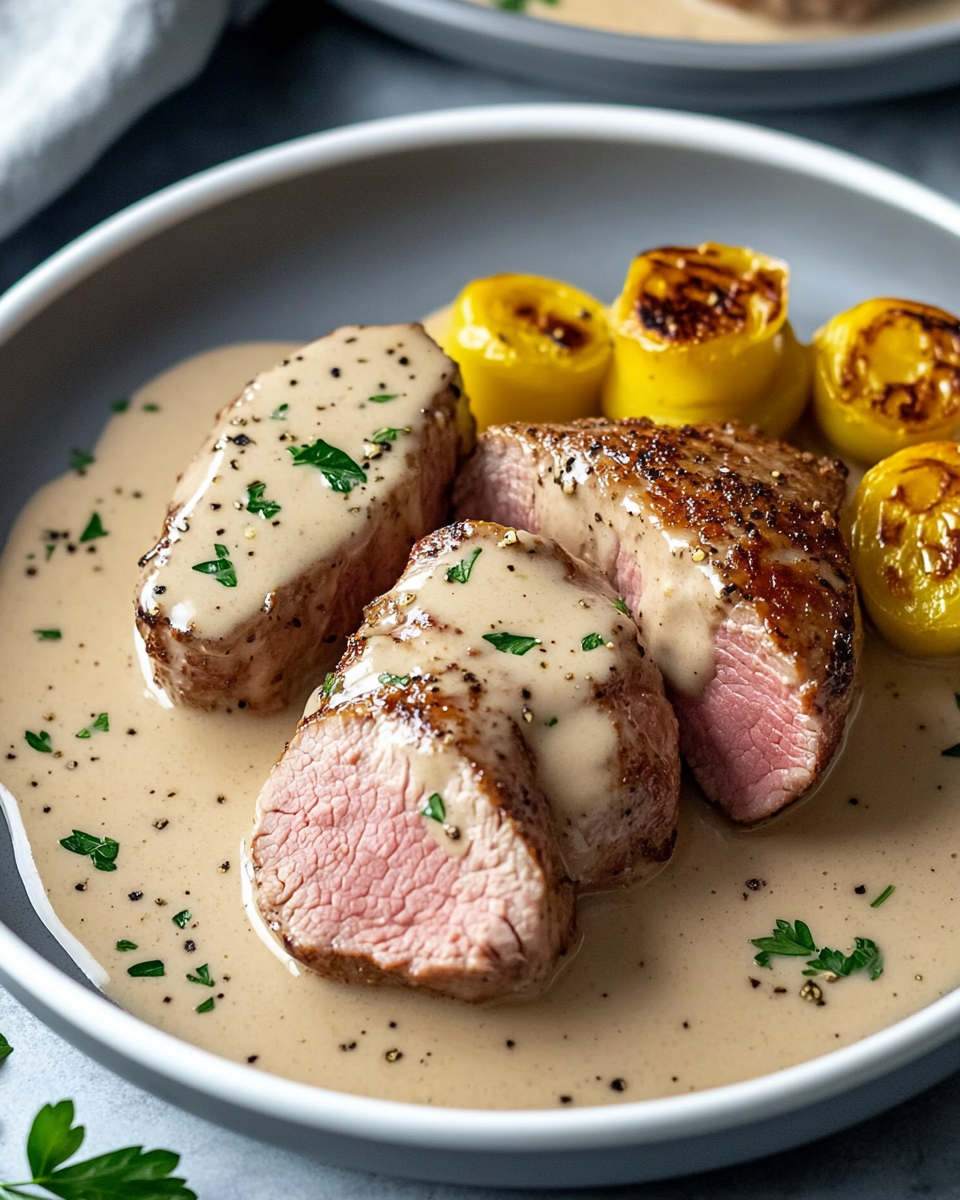The perfect harmony of flavor and elegance, this Pork Tenderloin with Dijon Cream Sauce is a show-stopping main dish you’ll want to make again and again. The juicy, oven-roasted pork is seared to golden perfection before being topped with a luscious, creamy Dijon sauce that’s bursting with aromatic herbs and rich, savory depth. Whether you’re cooking to impress or just want a weeknight meal that feels special, this recipe delivers. It’s simple enough for busy evenings but refined enough to serve at a dinner party. Pair it with roasted vegetables or buttery mashed potatoes for a complete and unforgettable meal.
Full Recipe:
Ingredients:
-
1 ½ lbs pork tenderloin
-
1 tablespoon olive oil
-
Salt and pepper, to taste
-
2 tablespoons unsalted butter
-
1 shallot, finely chopped
-
3 cloves garlic, minced
-
½ cup chicken broth
-
1 cup heavy cream
-
2 tablespoons Dijon mustard
-
1 teaspoon Worcestershire sauce
-
½ teaspoon dried thyme
-
Fresh parsley, chopped (for garnish)
Directions:
-
Preheat oven to 400°F (200°C).
-
Trim pork tenderloin of any silver skin and pat dry with paper towels.
-
Season the tenderloin generously with salt and pepper.
-
In a large oven-safe skillet, heat olive oil over medium-high heat.
-
Sear pork on all sides until golden brown, about 2-3 minutes per side.
-
Transfer the skillet to the oven and roast for 15–18 minutes, or until the internal temperature reaches 145°F (63°C).
-
Remove pork from the skillet and let rest under foil.
-
Meanwhile, return the skillet to the stovetop and melt butter over medium heat.
-
Add shallot and garlic; sauté for 1–2 minutes until fragrant.
-
Pour in chicken broth, scraping up brown bits from the bottom of the pan.
-
Stir in heavy cream, Dijon mustard, Worcestershire sauce, and thyme.
-
Simmer until sauce thickens slightly, about 5–6 minutes.
-
Slice the pork and spoon the creamy Dijon sauce over the top.
-
Garnish with chopped parsley and serve hot.
Prep Time: 10 minutes | Cooking Time: 30 minutes | Total Time: 40 minutes
Kcal: 420 kcal | Servings: 4 servings
The Ultimate Guide to Pork Tenderloin with Dijon Cream Sauce
Pork tenderloin is one of the most versatile and tender cuts of meat, beloved for its mild flavor and lean texture. When paired with a rich and tangy Dijon cream sauce, this dish transforms into an indulgent experience perfect for both weeknight dinners and elegant dinner parties. The combination of seared, oven-roasted pork and velvety, herb-infused cream is a testament to the power of simple ingredients elevated by proper technique and care.
In this article, we’ll explore the origins of this flavor combination, offer serving suggestions, cooking tips, variations, wine pairings, and help you understand why this dish deserves a permanent place in your recipe rotation.
Why Pork Tenderloin is a Star Ingredient
Pork tenderloin is a lean cut that comes from the muscle that runs along the backbone. It’s known for its tenderness and is often referred to as the “filet mignon of pork.” Because it contains very little fat, it cooks quickly and benefits from high-heat cooking methods such as searing and roasting.
What makes pork tenderloin especially appealing is its neutrality it serves as a blank canvas for bolder flavors like the mustardy zing of Dijon and the creamy richness of heavy cream. It’s also widely available and budget-friendly compared to other premium cuts, making it ideal for home cooks seeking luxury on a budget.
The Magic of Dijon Mustard in Cooking
Dijon mustard, originating from the French city of Dijon, has a sharp, piquant flavor profile that sets it apart from regular yellow mustard. It’s made with brown or black mustard seeds and often blended with white wine or wine vinegar, creating a deeply aromatic and spicy condiment that melds beautifully with cream-based sauces.
In this recipe, Dijon mustard does more than add flavor it acts as an emulsifier, helping the sauce achieve a smooth and glossy finish. It balances the richness of the cream and butter, and its tang cuts through the natural sweetness of pork, enhancing each bite with layers of complexity.
Creating Depth with Shallots, Garlic, and Herbs
The base of the cream sauce begins with sautéed shallots and garlic. Shallots offer a subtle onion flavor with hints of sweetness, while garlic provides a pungent aromatic backbone. Together, they infuse the sauce with warm, earthy undertones.
Dried thyme is often used for its woody and peppery notes, but you can also experiment with rosemary, sage, or a mix of herbs like herbes de Provence for a more Mediterranean flair. A splash of Worcestershire sauce adds umami, giving the sauce a deeper, more savory character that complements the pork beautifully.
Cooking Technique: Sear, Roast, and Rest
One of the keys to achieving juicy pork tenderloin is mastering the cooking technique. Start with a hot, oven-safe skillet to sear the meat on all sides. This not only builds flavor through the Maillard reaction but also creates a crust that locks in juices.
After searing, transfer the pork to a preheated oven to finish cooking. A meat thermometer is your best friend here pull the tenderloin at 145°F (63°C) for a perfectly pink center. Don’t skip the resting step; letting the pork sit under foil for a few minutes allows juices to redistribute, resulting in a more succulent final product.
Sauce Perfection: Silky, Balanced, and Bold
The Dijon cream sauce is the soul of this dish. Once the pork is done roasting, use the same skillet (without cleaning it) to prepare the sauce. This ensures that all the flavorful brown bits from the pork called fond are incorporated.
Deglazing the pan with chicken broth lifts these bits and intensifies the base of the sauce. From there, heavy cream adds body, while Dijon mustard provides sharpness. Let the sauce simmer until it thickens slightly enough to coat the back of a spoon before spooning it generously over sliced pork.
Garnishing with freshly chopped parsley adds a pop of color and freshness, balancing the richness of the dish.
Perfect Pairings: Sides That Shine
This luxurious main dish deserves thoughtfully paired side items that complement its flavors without overwhelming them. Here are a few ideal options:
-
Buttery Mashed Potatoes: Creamy potatoes serve as a mild base that soaks up the Dijon sauce beautifully.
-
Garlic Roasted Asparagus or Green Beans: These bright, slightly crunchy veggies contrast the richness of the pork.
-
Herbed Rice Pilaf: Offers a light, aromatic option that doesn’t compete with the bold sauce.
-
Crusty Artisan Bread: Perfect for mopping up every last drop of the luscious sauce.
Wine Pairing Suggestions
When selecting a wine to pair with this dish, aim for something that can balance the richness of the cream and stand up to the mustard’s bold flavor.
-
White Wine: A lightly oaked Chardonnay brings out the creaminess, while a crisp Sauvignon Blanc cuts through the sauce’s richness.
-
Red Wine: Pinot Noir is a fantastic red option. Its light body and fruity acidity won’t overpower the pork but will enhance its depth.
For a non-alcoholic option, try a sparkling apple cider or a chilled glass of iced tea with lemon to bring brightness and contrast.
Variations to Try
Once you’ve mastered the classic version, feel free to get creative:
-
Add Mushrooms: Sauté sliced mushrooms with the shallots for an earthy upgrade.
-
Infuse Heat: Add a pinch of red pepper flakes or a splash of hot sauce for a spicier kick.
-
Use a Different Protein: The sauce pairs beautifully with chicken breast or thighs and even salmon for a pescatarian twist.
-
Make it Low-Carb: Serve over cauliflower mash or zoodles for a keto-friendly version.
Storing and Reheating Tips
Leftovers? Lucky you! This dish stores well and tastes even better the next day.
-
Storage: Store the pork and sauce separately in airtight containers in the fridge for up to 3 days.
-
Reheating: Gently reheat the pork in a covered skillet with a splash of broth or water to prevent it from drying out. Warm the sauce separately over low heat, stirring frequently to maintain its smooth texture.
Avoid microwaving for best results it can overcook the pork and cause the sauce to separate.
Conclusion:
Pork Tenderloin with Dijon Cream Sauce is more than just a recipe it’s an experience of refined comfort and bold, balanced flavors. From the moment the pork hits the hot skillet to the final drizzle of creamy mustard sauce, every step builds toward a memorable, crowd-pleasing meal.
Its elegance lies in its simplicity. With just a handful of pantry staples and a bit of attention to technique, you can create a dish that rivals any restaurant entrée. Whether you’re preparing a cozy family dinner, hosting guests, or simply treating yourself, this recipe delivers the kind of flavor and satisfaction that only comes from home-cooked perfection.






